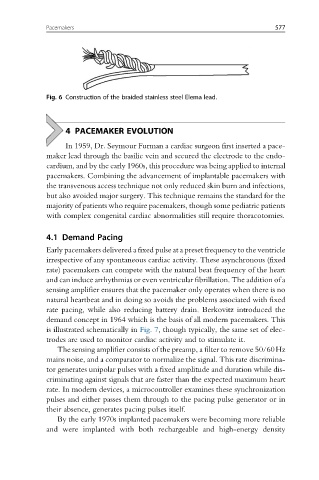Page 585 - Handbook of Biomechatronics
P. 585
Pacemakers 577
Fig. 6 Construction of the braided stainless steel Elema lead.
4 PACEMAKER EVOLUTION
In 1959, Dr. Seymour Furman a cardiac surgeon first inserted a pace-
maker lead through the basilic vein and secured the electrode to the endo-
cardium, and by the early 1960s, this procedure was being applied to internal
pacemakers. Combining the advancement of implantable pacemakers with
the transvenous access technique not only reduced skin burn and infections,
but also avoided major surgery. This technique remains the standard for the
majority of patients who require pacemakers, though some pediatric patients
with complex congenital cardiac abnormalities still require thoracotomies.
4.1 Demand Pacing
Early pacemakers delivered a fixed pulse at a preset frequency to the ventricle
irrespective of any spontaneous cardiac activity. These asynchronous (fixed
rate) pacemakers can compete with the natural beat frequency of the heart
and can induce arrhythmias or even ventricular fibrillation. The addition of a
sensing amplifier ensures that the pacemaker only operates when there is no
natural heartbeat and in doing so avoids the problems associated with fixed
rate pacing, while also reducing battery drain. Berkovitz introduced the
demand concept in 1964 which is the basis of all modern pacemakers. This
is illustrated schematically in Fig. 7, though typically, the same set of elec-
trodes are used to monitor cardiac activity and to stimulate it.
The sensing amplifier consists of the preamp, a filter to remove 50/60Hz
mains noise, and a comparator to normalize the signal. This rate discrimina-
tor generates unipolar pulses with a fixed amplitude and duration while dis-
criminating against signals that are faster than the expected maximum heart
rate. In modern devices, a microcontroller examines these synchronization
pulses and either passes them through to the pacing pulse generator or in
their absence, generates pacing pulses itself.
By the early 1970s implanted pacemakers were becoming more reliable
and were implanted with both rechargeable and high-energy density

